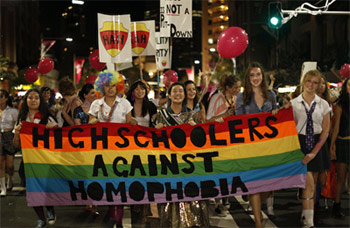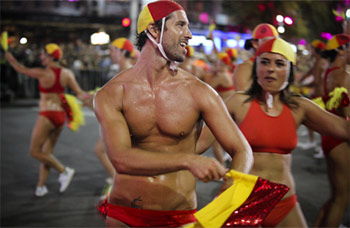The following is an excerpt from the Sydney Morning Herald:
...
While people may think party before politics, Mardi Gras still serves as a reminder that the quest for visibility and acceptance for sexual and gender minorities continues in Australia.
Peter Madden, the Christian Democratic Party’s candidate for Sydney, reminded us of this, when he said: ‘‘What [Mardi Gras] has become is a parade of live porn ... The concepts of hyper-tolerance lead to anarchy, and we see that anarchy on the streets of Sydney’’.
It is unclear what Madden is referring to in relation to ‘‘hyper-tolerance’’. But such a claim seems at odds with the fact that discrimination, vilification and harassment remain problems in Australia.
In terms of legislative equality, the goal of public recognition continues to be hindered by the exclusion of non-heterosexual couples from marriage in Australia. Marriage remains the most privileged means by which the state confers legal benefits to a couple. Denying same-sex couples access to such an institution reinforces social stigmas that the intimacy shared between gay or lesbian couples is of less significance than that of a heterosexual couple.
Correspondingly, the access to wide-ranging exemptions to anti-discrimination laws continues to provide moral justifications for people to discriminate. Students can be expelled from non-government schools for choosing to publicly disclose their sexuality. Same-sex couples may be denied access to health or aged-care services because some faith-based agencies do not respect the rights of gay men and lesbians to access services provided to heterosexuals.
Vilification and violence based on sexual orientation or sex and/or gender identity is rife in Australia. Despite the rhetoric of tolerance and inclusion, visibility has not led to social acceptance.
For many same-sex attracted young people, being ‘‘out and proud’’ has led to peer shaming. Similarly, for gender-diverse youth who choose to express their identity outside the male/female dichotomy, what is perceived as a failure to perform their gender properly has led to intimidation and humiliating conduct.

Mardi Gras Parade 2010. Photos by Richard Kendall via Flickr

Mardi Gras Parade 2010. Photos by Jonathan May via Flickr
Writing Themselves In 3, a report on harassment of same-sex attracted and gender-questioning young people released at the end of last year, noted that more than 60 per cent reported vilification due to their perceived sexuality; a significant majority of the abuse was based in schools.
With such legal and symbolic obstacles to social inclusion, how can we claim that equality has been achieved?
Mardi Gras, however, does not simply reflect a struggle for legal equality — it represents the coming together of a community defined by its cultural and sexual differences. Mardi Gras is a powerful political symbol because of the diversity it represents. It is not just about being gay or lesbian, it is about having sex, sexuality and gender differences that intersect with so many other facets of our lives, such as race, age, ability, religion, socio-economic status and geography.
...

